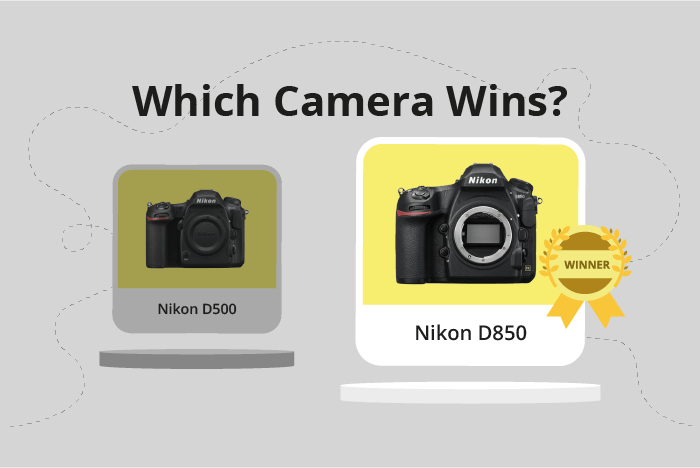Nikon D500 vs D850 Comparison
Nikon D500

Nikon D850

The Nikon D850 outshines the Nikon D500 with a score of 82/100, a 7-point lead over the D500’s 75/100. Both cameras are DSLRs and were released within a year of each other, with the D500 in 2016 and the D850 in 2017. They share similar dimensions, but the D850 is slightly heavier at 1005g compared to the D500’s 860g.
The D850’s higher score reflects its superior performance and features, justifying its launch price of $3300, which is $1300 more than the D500. However, the D500 still holds its own as a more budget-friendly option with a solid score and performance.
Considering their respective scores and specifications, the Nikon D850 stands as the better camera, while the Nikon D500 remains a reliable and more affordable choice.
Nikon D500 vs D850 Overview and Optics
The Nikon D850 outperforms the Nikon D500 in optics, scoring 79/100 compared to the D500’s 69/100. Both cameras share several specifications, including a CMOS sensor, the Expeed 5 processor, Nikon F lens mount, and lack of image stabilization. Despite these similarities, the D850 excels in certain aspects, making it the superior choice in terms of optics.
The D850 has a higher resolution with 45.7 megapixels, compared to the D500’s 20.9 megapixels. This allows the D850 to capture more detail and produce higher quality images. Additionally, the D850 features a full-frame sensor, whereas the D500 has an APS-C sensor. The full-frame sensor contributes to improved image quality, better low-light performance, and increased dynamic range. Furthermore, the D850 boasts a DXOMARK sensor score of 100, surpassing the D500’s score of 84, which highlights the D850’s superior sensor performance.
On the other hand, the D500 has a faster shooting speed of 10 frames per second, compared to the D850’s 7 frames per second. This makes the D500 more suitable for action photography, where capturing fast-moving subjects is crucial.
Taking these factors into consideration, the Nikon D850 proves to be the better camera in terms of optics due to its higher resolution, full-frame sensor, and superior DXOMARK sensor score. However, the Nikon D500 may still be a viable choice for those who prioritize shooting speed, such as sports or wildlife photographers.
Nikon D500 vs D850 Video Performance
The Nikon D500 and Nikon D850 both have a video score of 70/100, indicating that they share similar video capabilities. These cameras have several common specifications, such as a max video resolution of 4K, max video dimensions of 3840 x 2160, and a max video frame rate of 30fps. Additionally, both cameras have built-in time-lapse functionality.
Despite their equal scores, the Nikon D500 offers some advantages over the D850. The D500 is known for its fast autofocus performance during video recording, which is essential for capturing moving subjects. Furthermore, the D500 is more compact and lightweight compared to the D850, making it a more portable option for videographers who need to travel with their gear.
Conversely, the Nikon D850 also has its strengths when it comes to video capabilities. The D850 features a higher-resolution sensor (45.7MP) compared to the D500 (20.9MP), which allows for more detailed video footage. Additionally, the D850 has a better dynamic range, which results in improved video quality in challenging lighting situations.
While both cameras excel in terms of video performance, the choice between the Nikon D500 and Nikon D850 ultimately depends on individual preferences and requirements. The D500 is suitable for those who prioritize fast autofocus and portability, while the D850 is ideal for those who value high-resolution video and dynamic range.
Nikon D500 vs D850 Features and Benefits
The Nikon D500 and Nikon D850 both receive a feature score of 87/100, indicating that they are equally matched regarding their features. They share several specifications, including a 3.2-inch screen size, 2,359,000-dot screen resolution, touchscreen capabilities, Wi-Fi, and Bluetooth connectivity. Neither camera has GPS functionality.
The Nikon D500 outshines the D850 in one aspect: it has a flip screen. This feature provides flexibility for shooting from different angles and is especially useful for capturing images and videos in challenging positions. The flip screen can also offer protection to the screen when not in use, as it can be turned inward.
On the other hand, the Nikon D850 does not have any specific features that make it superior to the D500. The absence of a flip screen could be a disadvantage for some users, but it may not be a significant concern for others who do not require that functionality.
Considering the features of both cameras, it is clear that the Nikon D500 has a slight edge due to the presence of a flip screen. This advantage may make it more appealing for users who value this feature. However, since both cameras have the same feature score and share several specifications, the choice between the two cameras ultimately depends on the individual preferences and requirements of the user.
Nikon D500 vs D850 Storage and Battery
The Nikon D850 outperforms the Nikon D500 in storage and battery, scoring 84/100 compared to the D500’s 79/100. Both cameras possess two memory card slots and accept SD/SDHC/SDXC (UHS-II compatible) and XQD cards. However, the D850 surpasses the D500 in battery life, providing 1840 shots per charge as opposed to the D500’s 1240 shots.
The D850’s advantage lies in its battery type, the EN-EL15a, which offers longer-lasting power than the D500’s EN-EL15 battery. Despite this difference, neither camera supports USB charging. While the D850 has a clear edge in battery life, the D500 still offers a decent number of shots per charge.
Considering the storage and battery aspect, the Nikon D850 proves to be a better choice thanks to its longer battery life, while the Nikon D500 remains a suitable option for those who don’t require extensive shooting capacity.
Alternatives to the Nikon D500 and D850
Are you still undecided about which camera is right for you? Have a look at these popular comparisons that feature the Nikon D500 or the Nikon D850:

